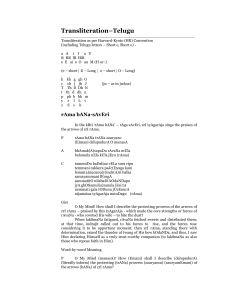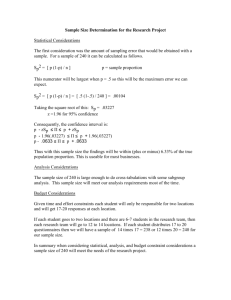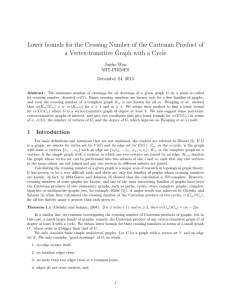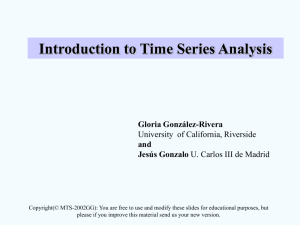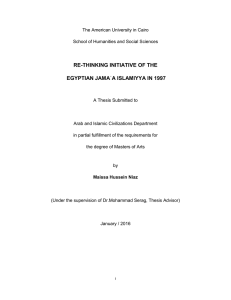MODEL TRACKING FOR RISK PROBLEMS LAKHDAR AGGOUN and LAKDERE BENKHEROUF
advertisement
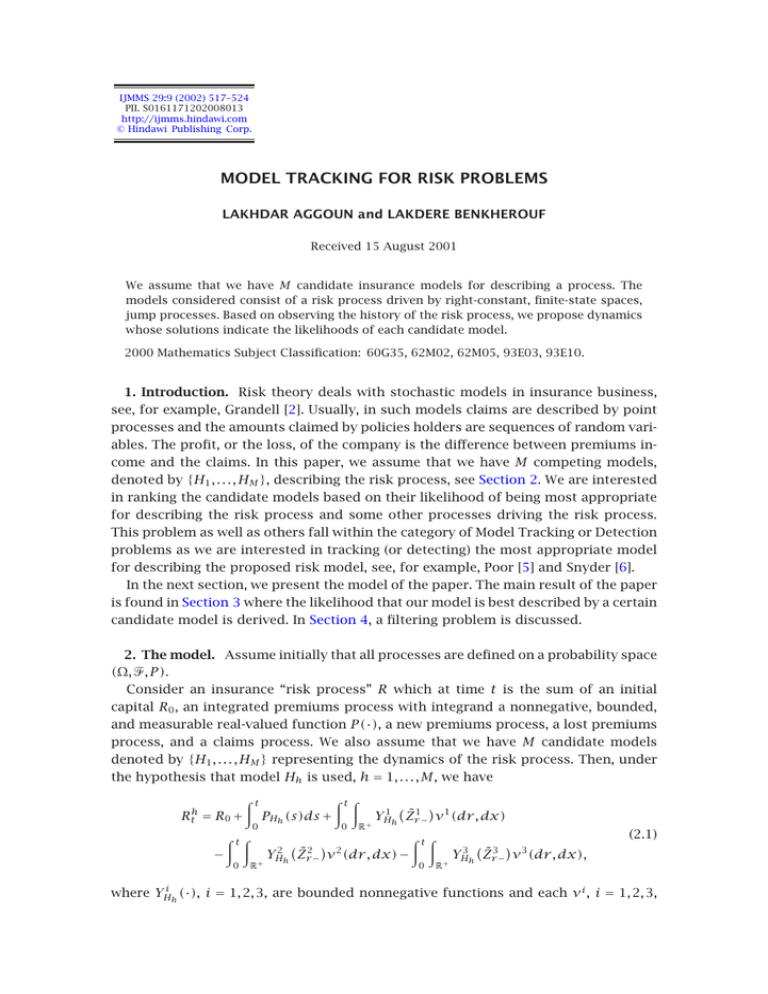
IJMMS 29:9 (2002) 517–524
PII. S0161171202008013
http://ijmms.hindawi.com
© Hindawi Publishing Corp.
MODEL TRACKING FOR RISK PROBLEMS
LAKHDAR AGGOUN and LAKDERE BENKHEROUF
Received 15 August 2001
We assume that we have M candidate insurance models for describing a process. The
models considered consist of a risk process driven by right-constant, finite-state spaces,
jump processes. Based on observing the history of the risk process, we propose dynamics
whose solutions indicate the likelihoods of each candidate model.
2000 Mathematics Subject Classification: 60G35, 62M02, 62M05, 93E03, 93E10.
1. Introduction. Risk theory deals with stochastic models in insurance business,
see, for example, Grandell [2]. Usually, in such models claims are described by point
processes and the amounts claimed by policies holders are sequences of random variables. The profit, or the loss, of the company is the difference between premiums income and the claims. In this paper, we assume that we have M competing models,
denoted by {H1 , . . . , HM }, describing the risk process, see Section 2. We are interested
in ranking the candidate models based on their likelihood of being most appropriate
for describing the risk process and some other processes driving the risk process.
This problem as well as others fall within the category of Model Tracking or Detection
problems as we are interested in tracking (or detecting) the most appropriate model
for describing the proposed risk model, see, for example, Poor [5] and Snyder [6].
In the next section, we present the model of the paper. The main result of the paper
is found in Section 3 where the likelihood that our model is best described by a certain
candidate model is derived. In Section 4, a filtering problem is discussed.
2. The model. Assume initially that all processes are defined on a probability space
(Ω, Ᏺ, P ).
Consider an insurance “risk process” R which at time t is the sum of an initial
capital R0 , an integrated premiums process with integrand a nonnegative, bounded,
and measurable real-valued function P (·), a new premiums process, a lost premiums
process, and a claims process. We also assume that we have M candidate models
denoted by {H1 , . . . , HM } representing the dynamics of the risk process. Then, under
the hypothesis that model Hh is used, h = 1, . . . , M, we have
Rth = R0 +
−
t
t
0
0
PHh (s)ds +
R+
t
0
R+
YH1h Z̃r1− ν 1 (dr , dx)
YH2h Z̃r2− ν 2 (dr , dx) −
t
0
R+
YH3h Z̃r3− ν 3 (dr , dx),
(2.1)
where YHi h (·), i = 1, 2, 3, are bounded nonnegative functions and each ν i , i = 1, 2, 3,
518
L. AGGOUN AND L. BENKHEROUF
is an integer-valued random measure which, under probability measure P , has predictable compensator (see Jacod [3]) ν̄ i function of Zti .
Here Z̃ti , i = 1, 2, 3, t ∈ R+ , are finite-state spaces processes with right-constant
sample paths on the state spaces S̃ i = {s1i , . . . , sni i }; s i will denote the (column) vector
(s1i , . . . , sni i ) .
Suppose 1 ≤ ≤ N, and for j ≠ πi (x) =
ni
x − sj ,
(2.2)
j=1
and φi (x) = πi (x)/πi (s ); then φi (sj ) = δj and φi = (φi1 , . . . , φini ) is a bijection
i
}; eji is the standard basis
of the set S̃ i = {s1i , . . . , sni i } with the set S i = {e1i , e2i , . . . , en
i
(column) vector in Rni with unity in the jth position and zero elsewhere. Consequently,
without loss of generality, we consider processes Zti on S i for i = 1, 2, 3. If Zti ∈ S i
denotes the state of this process at time t ≥ 0, then the corresponding value of Z̃ti is
Zti , s i , where , denotes the inner product in Rni .
Let Tki (ω) be the kth jump time of Z i , δT i (ω) (dr ) the unit mass at time Tki (ω) and
δZ i
k
(eji ) is the unit mass at Z i i
Tk (ω)
T i (ω)
k
Zti
Since
(ω).
is a jump process taking values in the vector space Rni we can write
∆Zri .
(2.3)
Zti = Z0i +
0<r ≤t
Here
∆Zri = Zri − Zri −
=
ni ∞
δT i (ω) (dr )δZ i
eji − Zri −
j=1
k=1
k
T i (ω)
k
eji
(2.4)
i
∆
=
eji − Zri − µ Z dr , eji .
ni
j=1
We assume that each Zti has almost surely finitely many jumps in any finite interval
i
i
so that the random measure µ Z is σ -finite. Let µ̃ Z (dr , eji ) be the predictable comi
pensator of µ Z so that (2.5) leads to
Zti = Z0i +
ni t j=1
0
i
eji − Zri − µ̃ Z dr , eji + Wt ,
(2.5)
i i
µ Z dr , eji − µ̃ Z dr , eji .
(2.6)
where
∆
Wt =
ni t j=1
0
eji − Zri −
i
Now µ̃ Z factors into its Lévy system
i
µ̃ Z dr , eji = β eji , Zri − , r dF Zri − , r ,
(2.7)
519
MODEL TRACKING FOR RISK PROBLEMS
where dF (Zri − , r ) represents the conditional probability that the next jump occurs at
time r given the previous history of the process.
Assume that the nonnegative measure dF (Zri − , r ) is absolutely continuous with
respect to Lebesgue measure so that
(2.8)
dF Zri − , r = f Zri − , r dr
for some nonnegative function f (·).
On the set [Zri − ≠ eji ] we have, from (2.8) and (2.9), that
i
∆
µ̃ Z dr , eji = β eji , Zri − , r f Zri − , r dr = ai
jZri −
For 1 ≤ j ≤ ni put
aijj (r , ω) = −
(r , ω)dr .
aijk (r , ω).
(2.9)
(2.10)
k≠j
Define the matrix Ai (r , ω) = {aijk (r , ω)}. Then we have the representation
Zti = Z0i +
t
0
Ai (r , ω)Zri dr + Wti .
(2.11)
i
We assume here that the Z i ’s have no common jumps, that is, with ∆Zui = Zui −Zu−
and for i ≠ j
j
∆Zui ∆Zu = 0, ∀t > 0 a.s.
(2.12)
0<u≤t
Let
t = σ R u , 0 ≤ u ≤ t
denote the complete filtration generated by the risk process and let
Ᏻt = σ Rs , Zsi ; 1 ≤ i ≤ 3; s ≤ t
(2.13)
(2.14)
be the complete filtration generated by the risk process R and the processes Z i , i =
1, 2, 3.
Now, given the filtration , and, a set of competing hypotheses {H1 , . . . , HM }, where
Hh = {PHh (·); YHi h , i = 1, 2, 3}, we want to determine the dynamics to compute the
posterior probabilities
(2.15)
P Hh | t , 1 ≤ h ≤ M.
Consider a simple random variable α, where α ∈ {f1 , . . . , fM } and fh = (0, . . . , 1, . . . , 0)
∈ RM . The “1” here is in position h. We suppose α is an indicator function such that
α = fh , that is, α, fh = 1 if and only if hypothesis Hh holds. Then (2.15) may be
rewritten as
(2.16)
P Hh | t = E α, fh | t ,
where the expectation is taken under probability measure P .
In Section 3, we propose dynamics to (2.15) whose solution is a solution of some
stochastic differential equation. Section 4 is concerned with a filtering problem.
520
L. AGGOUN AND L. BENKHEROUF
3. M-ary detection filters. Suppose P̄ is a reference probability, under which ν i ,
i = 1, 2, 3, have deterministic compensators H i (dx)dt independent of Z i , i = 1, 2, 3.
In order to recover the “real world” probability measure P under which the model dynamics introduced in Section 2 hold, define the Radon-Nikodym derivative Λ such that
dP = Λt ,
(3.1)
dP̄ Ᏻt
where (see Jacod and Shiryaev [4])
Λt = 1 +
3 t
0
i=1
R+
i
Λs− ν̃ i s, Zs−
, x − 1 ν i (dr , dx) − H(dx)dt .
(3.2)
However, in this section, we will be working under the “reference probability” P̄ . By
an abstract version of Bayes’ rule (see [1])
Ē Λt α, fh | t
P α = fh | t = E α, fh | t =
.
(3.3)
Ē Λt | t
Theorem 3.1. Let
∆
qth = Ē
α, fh Λt | t .
(3.4)
The unnormalized probability qth is given by the equation
qth = q0h +
i=1
0
3
i
i
h
E Zu−
, eji | u− ν̃ i u, eji , x −1 qu−
ν (du, dx)−H(dx)du .
3 t
R+
J=1
(3.5)
i
, eji | u− ] is evaluated under the probability measure P , given that the
Here E[Zu−
hypothesis Hh holds.
Proof. Using (3.2), we have
3
α, fh Λt = α, fh +
t
i=1
0
R+
i
, x − 1 ν i (ds, dx) − H(dx)ds ,
α, fh Λs− ν̃ i s, Zs−
(3.6)
with optional projection on the σ -field t
Ē Λt α, fh | t
3 t
= α, fh + Ē
i=1
0
R+
i
α, fh Λs− ν̃ i s, Zs−
, x − 1 ν i (ds, dx) − H(dx)ds | t .
(3.7)
Using (3.4) and [7, Chapter 7, Lemma 3.2] to exchange stochastic integration and conditional expectation under P̄ , we have
3 t
h
h
qt = q0 +
0 R+
i=1
Ē
i
α, fh Λs− ν̃ i s, Zs−
, x −1 | s− ν i (ds, dx)−H(dx)dt . (3.8)
MODEL TRACKING FOR RISK PROBLEMS
521
Now
Ē
i
, x − 1 | s−
α, fh Λs− ν̃ i s, Zs−
i
, x − 1 | s− ,
= E α, fh ν̃ i s, Zs−
Ē Λs− | s−
(3.9)
or
Ē
i
α, fh Λs− ν̃ i s, Zs−
, x − 1 | s−
i
, x − 1 | s− Ē Λs− | s− ,
= E α, fh ν̃ i s, Zs−
(3.10)
which, using elementary rules for conditional probabilities and Bayes rule, is
i
, x − 1 | α = fh , s− E α, fh | s− Ē Λt | s−
= E ν̃ i s, Zs−
Ē α, fh Λs− | s− i
= E ν̃ i s, Zs−
, x − 1 | α = fh , s−
Ē Λs− | s−
Ē Λs− | s−
i h
i
= E ν̃ s, Zs− , x − 1 | α = fh , s− qs− (using (3.4))
i
h
= E ν̃ i s, Zs−
, x | α = fh , s− − 1 qs−
.
Using the notation Zti =
3
i i
i
J=1 Zt , ej ej
(3.11)
gives (3.5).
Note that the normalized form of (3.5) is given by
qh
pth = M t
l
l=1 qt
.
(3.12)
As an example: suppose that the set of candidate models consists of two models, that
is, α ∈ {(1, 0), (0, 1)} and pt1 = P (α = (1.0) | t ) = E[α, (1, 0) | t ] and pt2 = P (α =
(0, 1) | t ) = E[α, (0, 1) | t ]. Define the log-likelihood or test statistic process,
pt1
lt = ln
pt2
qt1
= ln
.
qt2
(3.13)
Large values of l are in favor of model 1 whereas, small values of l are in favor of
model 2.
i
, eji | u− ]. The following
4. The filtering problem. Equation (3.5) contains E[Zu−
result gives the dynamics of the unnormalized version of this filter. Here we assume
that the random matrix A is adapted to the filtration . Again we work under the
“reference probability” P̄ , under which ν i , i = 1, 2, 3, have deterministic compensators
H i (dx)dt independent of Z i , i = 1, 2, 3.
Theorem 4.1. Let
∆
σt (, m, n) = Ē
3 3 2
Zt1 , e1 Zt2 , em
Zt , en Λt | t .
(4.1)
522
L. AGGOUN AND L. BENKHEROUF
The unnormalized probability process σt (, m, n) satisfies the stochastic integral equation
σt (, m, n) = σ0 (, m, n)
3 t
+
σu− (, m, n) ν̃ i u, eji , x − 1 ν i (dr , dx) − H(dx)dt
i=1
+
k1
+
0
t
k2
+
0
t
0
t
k3
0
R+
a1k1 (u, ω)σu k1 , m, n du
(4.2)
a2mk2 (u, ω)σu , k2 , n du
a3nk3 (u, ω)σu , m, k3 du.
Proof. Note that (2.11) gives
t
A1 (u, ω)Zu1 , e1 du + Wt1 , e1
Zt1 , e1 = Z01 , e1 +
0
t
1
= Z01 , e1 +
a1k1 (u, ω) Zu−
, ek11 du + Wt1 , e1 .
k1
(4.3)
0
Since the processes Zt1 and Zt2 share no common jumps,
t
2
2
1
2
Zt1 , e1 Zt2 , em
= Z01 , e1 Z02 , em
+
Zu−
, e1 dZu2 , em
0
t
2
2
, em
Zu−
dZu1 , e1
+
0
= Z01 , e1
+
t
k1
0
t
2
2
a2mk2 (u, ω) Zu1 , e1 Zu−
, ek22 du
Z02 , em
+
k2
0
2
1
a1k1 (u, ω) Zu2 , em
, ek11 du
Zu−
t
t
2
2
1
2
Zu−
dVu1 , e1 +
Zu−
,
, em
, e1 dWu2 , em
+
0
0
2
3
2
3
Zt3 , en
= Z01 , e1 Z02 , em
Z03 , en
Zt1 , e1 Zt2 , em
t
1
2
2
3
, e1 Zu−
, em
Zu−
dZu3 , en
+
0
t
3
3
2
+
, en
Zu−
d Zu1 , e1 Zu2 , em
0
2
3
Z03 , en
= Z01 , e1 Z02 , em
t
2
Zu3 , ek33 du
a3nk3 (u, ω) Zu1 , e1 Zu2 , em
+
k3
+
0
t
k1
0
3
2
Zu2 , em
Zu1 , ek11 du
a1k1 (u, ω) Zu3 , en
MODEL TRACKING FOR RISK PROBLEMS
+
t
k2
0
523
3
2
a2mk2 (u, ω) Zu3 , en
Zu2 , em
Zu1 , ek11 du
t
3
3
2
2
Zu−
Zu−
dWu1 , e1
, en
, em
+
0
t
3
3
1
2
+
, en
, e1 dWu2 , em
Zu−
Zu−
0
t
1
2
2
3
, e1 Zu−
, em
Zu−
dWu3 , en
.
+
0
(4.4)
Using (3.2) and recalling that the processes Zt1 , Zt2 , Zt3 , and Λt share no common jumps
under P̄
2
3
2
3
d Λt Zt1 , e1 Zt2 , em
Zt3 , en
= Zt1 , e1 Zt2 , em
Zt3 , en
dΛt
(4.5)
2
3
+ Λt d Zt1 , e1 Zt2 , em
Zt3 , en
,
so
2
3
Zt3 , en
Λt Zt1 , e1 Zt2 , em
2
3
Z03 , en
= Z01 , e1 Z02 , em
+
3 t
R+
0
i=1
1
2
2
3
3
Zu−
Λu− Zu−
, e1 Zu−
, em
, en
×
+
t
k3
+
k1
+
0
t
0
t
k2
0
i
, eji ν̃ i u, eji , x − 1 ν i (du, dx) − H(dx)du
Zu−
j
a3nk3 (u, ω)Λu
2
Zu1 , e1 Zu2 , em
Zu3 , ek33 du
(4.6)
3
2
a1k1 (u, ω)Λu Zu3 , en
Zu2 , em
Zu1 , ek11 du
3
Zu2 , ek21 Zu1 , e1 du
a2mk2 (u, ω)Λu Zu3 , en
+ martingales.
Simplifying the integrand in the stochastic integral in (4.6) gives
3 t
i=1
0
1
2
2
3
3
Λu− Zu−
, e1 Zu−
, em
, en
Zu−
R+
×
i
i
i
i
Zu− , ej ν̃ u, ej , x − 1 ν i (du, dx) − H(dx)du
j
=
3 t
i=1
0
R+
1
2
2
3
3
Λu− Zu−
, e1 Zu−
, em
, en
Zu−
× ν̃ i u, eji , x − 1 ν i (du, dx) − H(dx)du .
(4.7)
524
L. AGGOUN AND L. BENKHEROUF
Conditioning each side of (4.6) on t , under the measure P̄ , and using again [7, Chapter
7, Lemma 3.2] to exchange stochastic integration and conditional expectation establishes the result.
In this paper, a risk model described by M candidate models was discussed. Detection filters were derived using measure change techniques.
Acknowledgment. The authors would like to acknowledge the support of Sultan
Qaboos University.
References
[1]
[2]
[3]
[4]
[5]
[6]
[7]
R. J. Elliott, L. Aggoun, and J. B. Moore, Hidden Markov Models, Estimation and Control,
Applications of Mathematics, vol. 29, Springer-Verlag, New York, 1995.
J. Grandell, Aspects of Risk Theory, Springer Series in Statistics: Probability and Its Applications, Springer-Verlag, New York, 1991.
J. Jacod, Calcul Stochastique et Problèmes de Martingales [Stochastic Calculus and Martingale Problems], Lecture Notes in Mathematics, vol. 714, Springer, Berlin, 1979
(French).
J. Jacod and A. N. Shiryaev, Limit Theorems for Stochastic Processes, Grundlehren der mathematischen Wissenschaften, vol. 288, Springer-Verlag, Berlin, 1987.
H. V. Poor, An Introduction to Signal Detection and Estimation, Springer Texts in Electrical
Engineering, Springer-Verlag, New York, 1988.
D. L. Snyder, Filtering and detection for doubly stochastic Poisson processes, IEEE Trans.
Information Theory IT-18 (1972), 91–102.
E. Wong and B. Hajek, Stochastic Processes in Engineering Systems, Springer Texts in Electrical Engineering, Springer-Verlag, New York, 1985.
Lakhdar Aggoun and Lakdere Benkherouf: Department of Mathematics and Statistics, Sultan Qaboos University, P.O. Box 36, Al-Khod 123, Sultanate of Oman
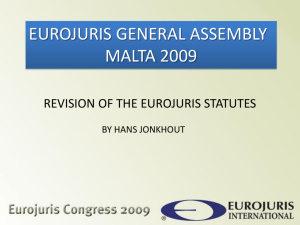
![Haar Functions Define functions e : [0, 1] → C by ](http://s2.studylib.net/store/data/011258628_1-58314f1c33aa86f924a14ef5f49f7c22-300x300.png)
